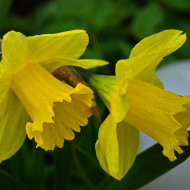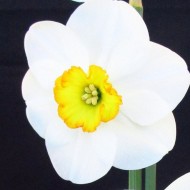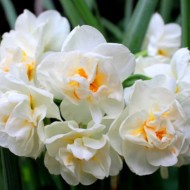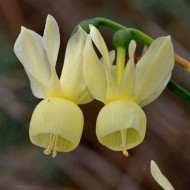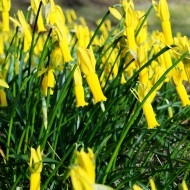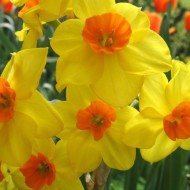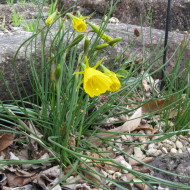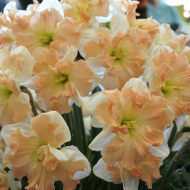Meet the daffodil: types and secrets of cultivation
Content
Characteristics and description of the daffodil flower
In nature, there are more than 60 species of these plants - perennial bulbous flowers of the Amaryllis family. About 25 cultivated, there are also many hybrids. The habitat of wild varieties is the Mediterranean, Asian countries, southern Europe.
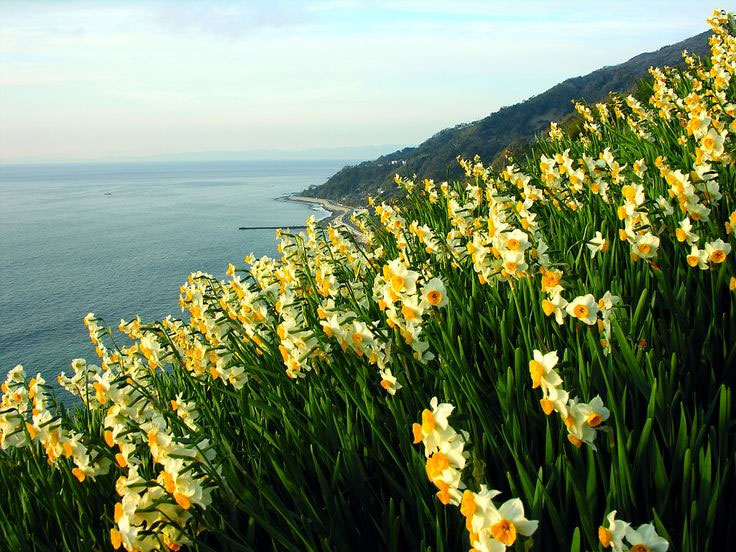
Although at first glance the varieties of daffodils are similar, if you look closely at the numerous photos, a clear heterogeneity is noticeable - the specimens differ in color and shape. The culture can be described as follows:
- The bush is formed from a dense bulb that has different sizes and shapes. The root is straight, annual (baby bulbs are used for reproduction).
- The straight, leafless stem is covered with ribbon-like foliage growing directly from the bulb. Height varies from 10 cm for small species to half a meter for tall ones.
- There can be from 2 to 4 leaves, the length and density depend on the variety.
- The stem is crowned with a flower - a single or a whole inflorescence of 2–8 buds 2–10 cm in diameter. The flower is formed from 6 petals. The central part is a column in the form of a crown and 6 stamens. The petals are smooth and double, the last petals have more.
There are white, yellow daffodils with different shades of orange. Some varieties have 2 or even 3 colors.
The plant is used in different ways:
- Daffodils are suitable for creating bouquets, decorating the garden landscape.
- Perfumers extract essential oils from the plant. There is a popular perfume called Black Narcissus.
- In folk medicine, decoctions of culture are used against migraines.
- To combat rodents, a poisonous alkaloid is extracted from the bulbs.
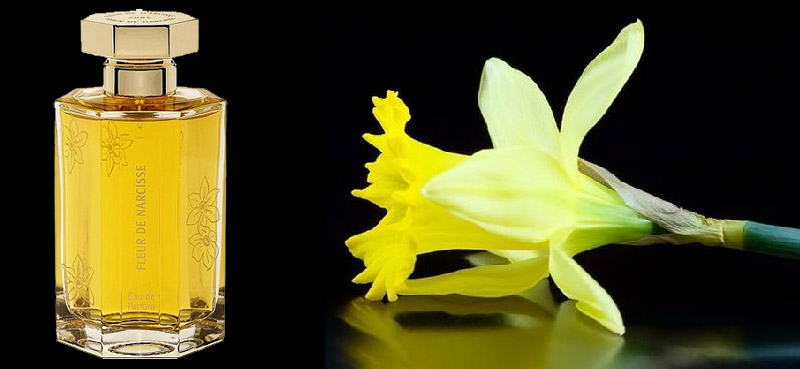
Popular species and varieties with photos
For convenience, the cultures used in horticulture were combined into 12 groups. Varieties belonging to the same class have similar characteristics.
Tubular (Trumpet)
The stem is high and strong. The central tubular crown is the same size or slightly longer than the flower petals. Bulbs are massive (about 5 cm). This species does not tolerate cold weather, in the central regions of Russia they need protection. The colors are monochromatic.
Representatives of the species:
- Dutch Master - yellow flower, diameter 11 cm, stem up to 30 cm;
- Golden Harvest - golden flower, diameter 12 cm, stem up to 40 cm;
- Mount Hood - milky white flower, diameter 10 cm, stem up to 35 cm.
Large cupped
The core crown grows half the length of the petals. The colors of the buds are different: white, light yellow, pink, deep red.Abundant flowering, normal reproduction. Miniature bulbs (up to 3.5 cm). In the middle lane they need winter shelter.
Representatives of the species:
- Cool Flame - two-tone (dark red core, white petals), wrinkled edges, diameter 10 cm, stem up to 30 cm;
- Salome - bicolor (heart is bright yellow, petals are creamy white), diameter 9 cm, stem up to 30 cm;
- Spring Pride - bicolor (white core with wrinkled dark pink outline, white petals), diameter 10 cm, stem up to 35 cm.
Small cupped
The crown grows only a few millimeters, the flowers are also medium-sized. The flowering season comes after the tubular and large-crowned ones. Abundant flowering, pleasant smell of buds, normal reproduction. In winters with little snow, it needs additional protection.
Representatives of the species:
- Audubon - stem up to 40 cm, two-color (dark orange core with a red outline, white petals), diameter 9 cm;
- Rockall - stem up to 45 cm, two-colored (heart is bright red, petals are light green), diameter 11 cm.
Terry (Double)
All representatives of the species form massive flowers, one stem bears from 1 to 4 buds. The color is different. If the inflorescences become too large, they need a support.
Terry species are capricious in care, do not tolerate sharp fluctuations in temperature and cold (do not bloom), need shelter. Because of this, they are rarely used in spring flower gardens.
Representatives of the species:
- Cheerfullness - stem up to 40 cm, holds 3-4 buds. Flower 4 cm in diameter, creamy white petals, bright yellow crown;
- Rip van Winkle - dwarf variety, stem up to 15 cm, deep yellow flower, pointed tips of the petals, looks like a dandelion in shape, 5 cm in diameter;
- Tahiti - stem 40 cm, rose-shaped flower, rich yellow petals, red heart, diameter 10 cm.
- Tubular
- Large-crowned
- Small-crowned
- Terry
Triandrus
The species was bred by crossing the three-stalked daffodil (from which it inherited immunity to diseases) with the garden one (adopted its decorative properties). It is small in size, on the stem, drooping inflorescences are formed in the form of umbrellas, 2-4 pieces each. The flowers smell good. The palette consists of white and yellow shades. Plants are afraid of the cold and need shelter even in the southern regions of the country.
Representatives of the species:
- Thalia - stem up to 40 cm, white, monochromatic flowers, up to 15 cm in diameter;
- Hawera - stem up to 15 cm in open ground (in a greenhouse up to 35 cm), pale yellow flower, 2.5 cm in diameter, cup-shaped core;
- Tresamble - stem up to 30 cm, bicolor flower (white petals, light lemon central part), diameter up to 8 cm.
Cyclamineus
They have a long narrow core and strongly curved petals. In the middle lane they bloom first (end of April). Stems are short, strong, drooping flowers. Flowering is friendly and long-lasting. They reproduce normally. The color in representatives of the species is only yellow. Bulbs shrink with age. Winter protection is required even in the southern regions.
Representatives of the species:
- Baby Dole - stem up to 30 cm, two-color flower (rich yellow petals, orange crown, corrugated contour), 7.5 cm in diameter;
- Jumblie is a miniature hybrid with a height of 10 cm, a flower with a diameter of 4 cm, monochromatic.
Jonquilla
The species includes late varieties. Several (from 3 to 8) miniature inflorescences are formed on the peduncles. The buds have a pronounced pleasant aroma. The stem is fragile, with lush flowering it needs support. The colors of the buds are limited.
Representatives of the species:
- Step Forward - stem up to 30 cm, yellow flowers (the middle is lighter) up to 7 cm in diameter;
- Hillstar - the parameters are the same, the petals are more elongated in comparison with Step Forward, the yellow color is richer;
- Suzy - stem up to 30 cm, bicolor bud (yellow petals, reddish-red crown), 7 cm in diameter.
Multi-flowered, or tacetate (Tazetta, Bunch flowered)
The buds are medium, fragrant. From 2 to 5 flowers are formed on the stem. Colors are white or yellow.They are afraid of cold weather - in the middle lane in winter they die without shelter.
The representative of the species is Geranium. Forms an inflorescence of 2-4 flowers, stem height up to 30 cm. The petals are white, the central part is deep orange, the diameter of the buds is 5.5 cm.
- Triandrus
- Cyclameniform
- Jonquilliaceae
- Tacetate
Poetic (Poeticus)
Named in honor of the progenitor - the poetic narcissist (N. poeticus). The flowers are massive, white, smell nice, the crown is low, the shape is simple. Hardy, immune to disease, frost-resistant (no winter shelter required). Blooming later.
There are few varieties of this species, some of them:
- Actaea - stem up to 40 cm, two-color flower (white petals, bright yellow center, red edging), diameter up to 9 cm;
- Poetaz - has a racemose shape.
Bulbocodium Hybrids
They belong to the wild-growing group originally from France. They are afraid of the cold, in central Russia they need protection. The British describe him as "a daffodil in a skirt." All hybrids have:
- semi-cylindrical dark green foliage;
- stem up to 15 cm;
- flowers in the form of funnels with a diameter of 3.5 cm with yellow petals.
The Cantabrian daffodil is another representative of the wild species that came from the south of Spain. The description is the same as the previous one, it differs only in the white color of the petals.
Split Corona
The core of the flower varies in size and length. A distinctive feature of the species is an uneven, fringed crown.
Representatives of the species:
- Shrike - stem up to 30 cm, bicolor flower (white petals, dark orange center, wrinkled), diameter up to 10 cm, long flowering;
- Orangery - stem up to 50 cm, two-color flower (white petals, orange core), diameter up to 10 cm;
- Printal - stem up to 35 cm, two-color flower (light green petals, yellow core, wrinkled outline), diameter up to 11.5 cm.
- Poetic
- Bulbocodium hybrids
- Split-crown
All species
This group includes varieties that did not fall into the previous ones.
Video "Description and cultivation of a daffodil"
This video provides a detailed description of the bulb culture, as well as the rules for planting and care.
Features of the agrotechnology of the narcissus
The culture loves sunshine, although a little shade in the midday heat won't hurt it. Based on the requirements of the selected variety, as well as being guided by the general rules of agricultural technology for daffodils, a place for a flower garden is selected in the garden.
Landing dates and rules
The best time for planting bulbs is considered to be the end of summer - beginning of autumn. The plant should have time to take root, it will take about a month. The soil should be nitrogen-potassium, therefore preliminary feeding is desirable.
The site is prepared by digging a shovel onto a bayonet, adding sand and fertilizers (mix humus and 60 g of nitrophoska per square of crops).
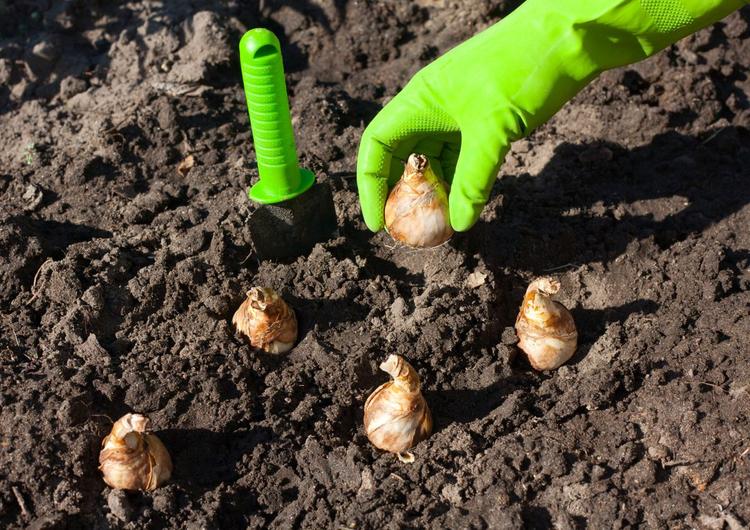
Landing is performed according to the algorithm:
- In a group, individual specimens are planted with a step of 10 cm, if seating is planned in the future, a step of 20 cm is kept if the flowers are planted in a permanent place.
- Dig holes three times the diameter of the bulb, leaving room for development. Depth - 10 cm.
- A handful of sand is thrown into the hole, 2 tablespoons of wood ash are added, planting material is stuck into this mixture.
- Fill halfway with soil mixed with compost. Watering.
- They fall asleep to the top with earth, lightly tamp.
Reproduction and transplantation
For propagation of crops of daffodils, two methods are suitable - daughter bulbs or separate bulbs. They begin to transplant if there are fewer shoots on the site every season. This usually occurs at 5–6 years of age. They pick up the moment when the leaves dry out a little, after which:
- the bulbs are carefully removed from the ground;
- shake off, cut off rotten fragments;
- folded in the shade to dry;
- after a couple of weeks, low-quality bulbs are discarded, the rest are stored in a dry, dark place until the next planting.
The later the bulbs are dug up, the worse their quality will be.

Care advice
The first month and a half after planting on dry days, the plants need to be watered, they need increased moisture. In addition, care includes:
- loosening the soil around the seedlings;
- weed removal;
- sanitary pruning of diseased shoots;
If some flowers begin to wither, it is advisable to pluck them so that the plant does not spend nutrient components to maintain their vital activity. In one place, daffodils grow for about 6 years without a transplant. In the first years, the soil is fed from time to time with nitrogen-potash fertilizers. This is done in several passes:
- In the spring, as soon as the first shoots appear. Nitrogen fertilizers (30 g per square meter of crops, diluted in water) are used in small doses, since an excess of nitrogen stimulates diseases, while weakened sprouts begin to grow rapidly.
- With the appearance of peduncles, a second top dressing is carried out (20 g per sq. M).
- In the season of bud setting, the third feeding is carried out - phosphorus fertilizers are added to the nitrogen-potassium mixture.
- The fourth feeding is needed to enhance flowering - only phosphorus and potassium are used.
A couple of years before planting the culture, it is advisable to fill the soil at the chosen place with fresh manure. Growing flowers, on the contrary, cannot be fertilized with manure, so as not to attract pests.
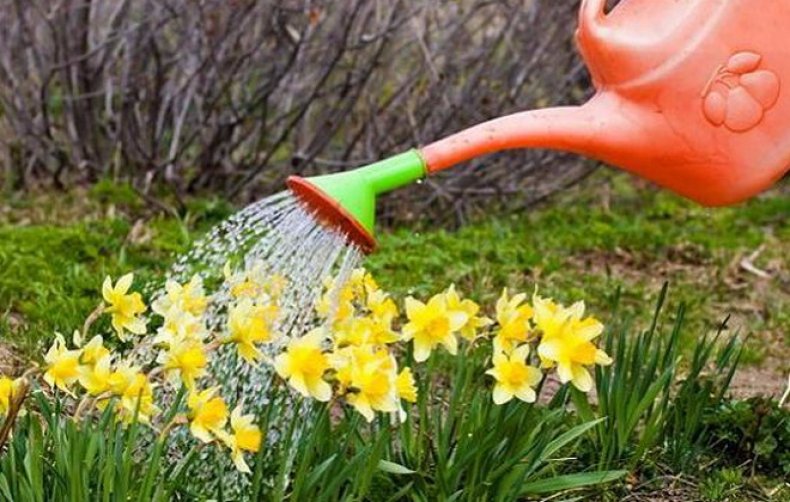
Wintering features
It all depends on the selected variety. Hardy daffodils are able to survive the winter without special protection, being covered with snow. But if there are mainly snowless winters in the region, or non-winter-hardy varieties have been purchased, a shelter is required. For this:
- before the onset of frost, the soil on the site is mulched, covering with fallen leaves, sawdust or peat;
- plants are covered with polyethylene or non-woven material.
If there is little snow, it is advisable to collect it in the near-root space of flowers, creating an additional insulating layer.
Major diseases and pests
Among the pests of culture, nematodes, daffodil flies and ticks are dangerous. Also, daffodils are usually affected by:
- fusarium;
- sclerotinosis;
- mosaic disease.
For the prevention of fungal ailments, the planting material is soaked in a fungicide solution. Hot water helps with narcissus flies and nematodes - the bulbs should lie in it for several hours.
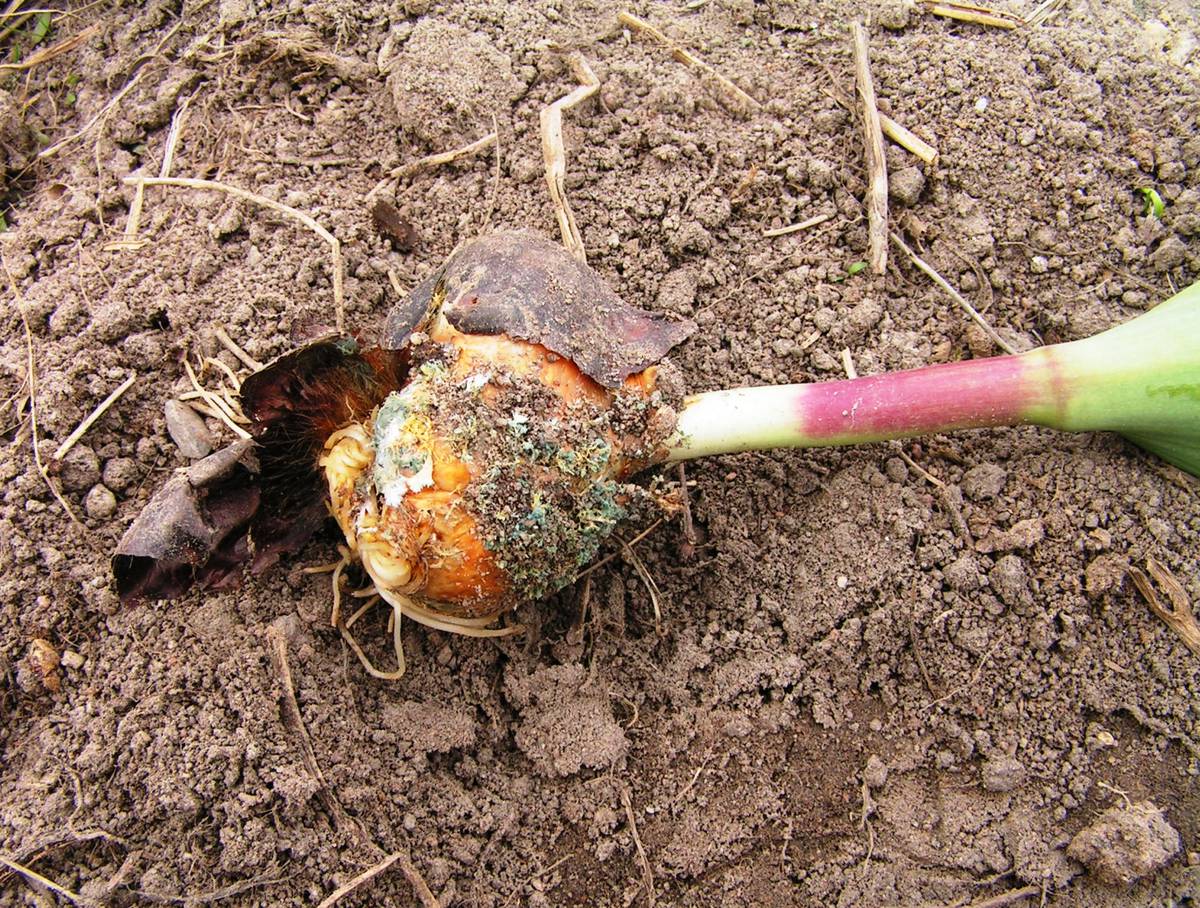
The use of daffodils in garden design
If you are not going to plant daffodils for an exhibition, you need to plant them in small tracts. Fading, the foliage of crops becomes sloppy, dies off for a long time, because the composition loses its appearance. The best option is groups of 5-7 pieces in combination with perennials such as geranium, cuff or hosta. Neighboring crops should be surrounded by daffodils in order to cover the wilting foliage by autumn.
Miniature varieties are suitable for decorating rock gardens, where they coexist with other beautiful crops that bloom after daffodils. Daffodils look great in pots and containers. When blooming, they are exposed in a prominent place, then hidden, caring until the end of the season.

When choosing applicants for garden beds, you need to focus not only on the appearance of flowers, but also on characteristics. By combining different varieties, a skilled florist is able to fill the entire garden with captivating beauty, pleasing to the eye all season.

